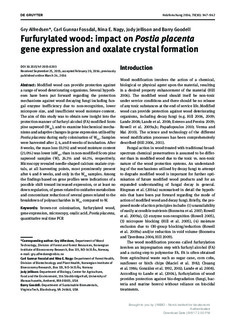| dc.contributor.author | Alfredsen, Gry | |
| dc.contributor.author | Fossdal, Carl Gunnar | |
| dc.contributor.author | Nagy, Nina Elisabeth | |
| dc.contributor.author | Jody, Jellison | |
| dc.contributor.author | Barry, Goodell | |
| dc.date.accessioned | 2017-11-27T10:24:13Z | |
| dc.date.available | 2017-11-27T10:24:13Z | |
| dc.date.created | 2016-04-01T09:50:30Z | |
| dc.date.issued | 2016-03-24 | |
| dc.identifier.citation | Holzforschung. 2016, 70 (10), 947-962. | nb_NO |
| dc.identifier.issn | 0018-3830 | |
| dc.identifier.uri | http://hdl.handle.net/11250/2468111 | |
| dc.description.abstract | Modified wood can provide protection against a range of wood deteriorating organisms. Several hypotheses have been put forward regarding the protection mechanisms against wood decaying fungi including fungal enzyme inefficiency due to non-recognition, lower micropore size, and insufficient wood moisture content. The aim of this study was to obtain new insight into the protection manner of furfuryl alcohol (FA) modified Scots pine sapwood (WFA), and to examine biochemical mechanisms and adaptive changes in gene expression utilised by Postia placenta during early colonisation of WFA. Samples were harvested after 2, 4, and 8 weeks of incubation. After 8 weeks, the mass loss (0.1%) and wood moisture content (21.0%) was lower inWFA, than in non-modified Scots pine sapwood samples (W), 26.1% and 46.1%, respectively. Microscopy revealed needle-shaped calcium oxalate crystals, at all harvesting points, most prominently present after 4 and 8 weeks, and only in the WFA samples. Among the findings based on gene profiles were indications of a possible shift toward increased expression, or at least no down regulation, of genes related to oxidative metabolism and concomitant reduction of several genes related to the breakdown of polysaccharides in WFA compared to W. | nb_NO |
| dc.language.iso | eng | nb_NO |
| dc.publisher | De Gruyter | nb_NO |
| dc.relation.uri | http://www.degruyter.com/view/j/hfsg.ahead-of-print/hf-2015-0203/hf-2015-0203.xml | |
| dc.subject | quantitative real time PCR | nb_NO |
| dc.subject | Postia placenta | nb_NO |
| dc.subject | oxalic acid | nb_NO |
| dc.subject | microscopy | nb_NO |
| dc.subject | gene expression | nb_NO |
| dc.subject | furfurylated wood | nb_NO |
| dc.subject | brown-rot colonisation | nb_NO |
| dc.title | Furfurylated wood: impact on Postia placenta gene expression and oxalate crystal formation | nb_NO |
| dc.type | Journal article | nb_NO |
| dc.type | Peer reviewed | nb_NO |
| dc.description.version | publishedVersion | nb_NO |
| dc.rights.holder | © 2016 Walter de Gruyter GmbH, Berlin/Boston | nb_NO |
| dc.source.pagenumber | 947-962 | nb_NO |
| dc.source.volume | 70 | nb_NO |
| dc.source.journal | Holzforschung | nb_NO |
| dc.source.issue | 10 | nb_NO |
| dc.identifier.doi | 10.1515/hf-2015-0203 | |
| dc.identifier.cristin | 1348187 | |
| dc.relation.project | Norges forskningsråd: 243663 | nb_NO |
| dc.relation.project | Norges forskningsråd: 179482 | nb_NO |
| dc.relation.project | NIBIO - Norsk institutt for bioøkonomi: 335008 | nb_NO |
| cristin.ispublished | true | |
| cristin.fulltext | original | |
| cristin.qualitycode | 1 | |
